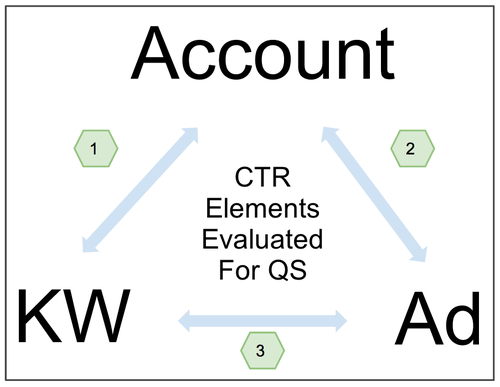Getting a high position on Google’s search results page is a key component of getting lots of visitors to your site but how do you get that great position for your ad without spending too much?
The way AdWords ranks ads is based on two main components: your bid and your quality score. Because the position of the ad is not based on the bid alone, something crazy sometimes happens… the ad in the highest position could be paying less for a click than the ads below it. That’s right, advertisers who know how to get a great quality score pay less than everyone else!
Here’s one of many examples we’ve seen where even a small increase in QS has a big impact on the average CPC an advertiser is paying.
So let’s take a look at how quality score works and how you can use it to your advantage to decrease your advertising costs.
How to pay less for new keywords in AdWords?
When you add new keywords to your account, Google has to make an educated guess about what value to set for the initial Quality Score. If you can figure out how to get the highest possible starting QS right out of the gates, you’ll pay less for your initial clicks.
So here’s how to get a better starting QS for new keywords: optimize your account QS by fixing the keywords that get a ton of impressions and have a QS that’s below the average for the account. But since Google doesn’t tell you what your account QS is, how do you put this advice into action? My favorite tool for monitoring account QS is Optmyzr (but I may be biased). It even gives me a prioritized lists of ad groups that I should optimize to boost my account QS. Other options include AdWords Scripts and some other SEM tools so research what option makes the most sense for your situation.
If you want to better understand the way Google uses data to set QS, take a look at the following.
To guess your starting QS, they look at the historical performance of a few things they may already know: your account QS, your typical performance for ads with a certain URL, and the performance of other advertisers for the keyword you’re adding. The following diagram represents the major components the AdWords system evaluates when determining quality score.

As you can see, there are 3 main factors: the account, the keyword and the ad. The ad component consists of sub-components including the ad text and the visible URL.
The QS algorithm’s goal is to predict the CTR for a particular ad impression based on historical data. It uses these 3 factors individually and also in combination with each other. Factor 1 represents how a keyword has performed in a particular account. Factor 2 represents how an ad text and its components have performed in a particular account and factor 3 represents how a particular keyword has performed with a particular ad text.
How to pay less for keywords you’ve had for a long time?
After at most 1,000 impressions for a keyword, AdWords has more than enough data to make a statistically sound judgment about the QS. Instead of relying on generic data like account QS, it can now use data about how the keyword performed with its ad text. If your keyword’s CTR is too low, that’s an indication to Google that users are not finding the ad relevant for that keyword. So your best bet is to either make the keyword more specific, for example by turning the keyword ‘dog’ into ‘dog food’ or by moving the keyword into a separate ad group with an ad text tailored for just this keyword. It simply comes down to finding a way to convince users to click your ad more frequently.
To improve QS, make your keywords more specific and improve your account structure by creating smaller and more tightly themed ad groups, each with ads tailored to the small set of keywords.
As a general best practice, I like to keep ad groups to no more than 20 keywords. While it’s not a hard and fast rule, I find that ad groups with more than 20 keywords can usually be split up into several smaller ad groups.
What about Landing Page Quality Score?
Landing Page Quality Score is an element AdWords started to consider because some advertisers had figured out how to game QS by writing must-click ads but then not delivering on the promise of the ad. For example, it’s really easy to get a high CTR by telling users they can get a free tablet for clicking an ad. But once they click, that promise usually turns out to be a scam.
It’s important to understand that this is why LPQ was introduced. While it can now boost the QS, it was originally intended to weed out bad advertisers. But it’s not a big component of QS. I say this because some advertisers believe they can get a better QS by creating unique landing pages for every keyword and while there’s nothing wrong with that, it’s probably not the best way to spend your limited time and resources. Focusing on highly relevant ads that get great CTRs is still the best way to boost QS.










